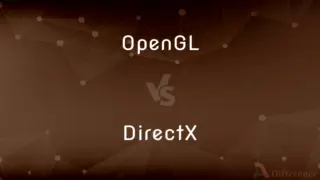Fuzzification vs. Defuzzification — What's the Difference?
By Tayyaba Rehman — Published on January 6, 2024
Fuzzification is the process of transforming crisp values into fuzzy sets, whereas Defuzzification converts fuzzy sets back into crisp, concrete values.

Difference Between Fuzzification and Defuzzification
Table of Contents
ADVERTISEMENT
Key Differences
Fuzzification is a crucial step in fuzzy logic systems, where it converts precise, crisp input values into fuzzy values, represented by membership functions. This process allows for handling imprecise or vague data. Defuzzification, in contrast, is the step where fuzzy values, processed through a fuzzy logic system, are translated back into precise, crisp output values.
During Fuzzification, real-world numerical values are mapped to degrees of membership in fuzzy sets, facilitating the handling of uncertain or ambiguous data. For example, a temperature of 70 degrees might be considered 'medium' to a certain degree. Defuzzification, conversely, takes fuzzy conclusions derived from fuzzy rules and computes a single crisp output, like deciding the exact speed of a fan based on room temperature.
Fuzzification caters to the subjective and imprecise nature of real-world human reasoning by allowing for partial membership in multiple categories. This makes it suitable for complex decision-making processes. Defuzzification, on the other hand, is necessary to make these fuzzy decisions usable in the real world, often using methods like centroid calculation or mean of maximum.
In Fuzzification, the input is typically a numerical value, and the output is a fuzzy degree of truth. This process is essential for systems that must operate with ambiguity. Defuzzification, meanwhile, takes the fuzzy logic conclusions and translates them into a specific action or value, crucial for practical applications like control systems.
The goal of Fuzzification is to create a rich, nuanced representation of reality by acknowledging and incorporating uncertainty. Defuzzification aims to distill this nuanced understanding into actionable, concrete decisions or values, bridging the gap between abstract fuzzy reasoning and concrete actions.
ADVERTISEMENT
Comparison Chart
Process
Converts crisp values to fuzzy sets
Converts fuzzy sets to crisp values
Purpose
Handles imprecise or vague data
Produces a concrete, actionable output
Output
Fuzzy degree of truth
Specific, crisp value or action
Role in Fuzzy Logic
Maps real-world values to fuzzy membership functions
Applies a method to derive a single crisp value
Application
Essential for interpreting ambiguous input
Necessary for implementing fuzzy logic in real-world use
Compare with Definitions
Fuzzification
Fuzzification is the process of converting crisp numbers into fuzzy sets.
In fuzzification, a temperature of 72 degrees might be somewhat 'hot' and somewhat 'warm'.
Defuzzification
Defuzzification applies methods like centroid calculation.
Defuzzification uses techniques like the 'mean of maximum' to resolve a fuzzy output.
Fuzzification
It involves assigning degrees of membership to fuzzy sets.
Fuzzification assigns a speed like 60 mph degrees of being 'fast' or 'moderate'.
Defuzzification
Defuzzification converts fuzzy values back into crisp numbers.
Defuzzification might determine a specific fan speed from fuzzy temperature inputs.
Fuzzification
Fuzzification incorporates uncertainty into decision-making.
Fuzzification helps an autonomous car understand 'near' and 'far' as a spectrum.
Defuzzification
It's essential for practical applications of fuzzy logic.
In a climate control system, defuzzification dictates the exact temperature setting.
Fuzzification
It's a key step in fuzzy logic systems.
Fuzzification allows a thermostat to interpret temperatures in terms of 'cool', 'warm', or 'hot'.
Defuzzification
It produces specific outputs from fuzzy logic conclusions.
Defuzzification helps an AI decide the exact amount of an ingredient to add in a recipe.
Fuzzification
Fuzzification handles vague or ambiguous data.
Fuzzification can categorize a slightly cloudy sky as both 'clear' and 'cloudy' to some extent.
Defuzzification
Defuzzification bridges fuzzy reasoning and concrete actions.
Defuzzification enables a fuzzy-based system to adjust lighting based on 'dim' or 'bright' inputs.
Common Curiosities
Why is Fuzzification important?
It's essential for handling imprecision and vagueness in real-world data within fuzzy logic systems.
What are common methods of Defuzzification?
Common methods include centroid calculation and the mean of maximum.
What is Fuzzification?
Fuzzification is the process of transforming crisp, exact values into fuzzy sets for fuzzy logic processing.
How does Defuzzification work?
Defuzzification converts the fuzzy sets obtained from fuzzy logic processing back into concrete, crisp values.
Are there different techniques for Fuzzification?
Yes, techniques vary based on the context and nature of the data being fuzzified.
Can Fuzzification handle subjective data?
Yes, it's particularly adept at interpreting subjective or ambiguous inputs.
How does Fuzzification aid in decision-making?
It allows systems to consider a range of possibilities and uncertainties, leading to more nuanced decisions.
Is Defuzzification always accurate?
Defuzzification aims for accuracy but the precision depends on the fuzzy logic model and methods used.
What's a practical example of Defuzzification?
In a smart thermostat, defuzzification decides the exact temperature to set based on fuzzy input.
Is Fuzzification used in everyday technology?
Yes, it's used in various applications like climate control systems and autonomous vehicles.
Does Defuzzification require complex algorithms?
It can, depending on the complexity of the fuzzy logic system and the desired precision of the output.
Can Defuzzification be automated?
Yes, it's typically an automated process within fuzzy logic systems.
What industries benefit from Fuzzification?
Industries like automation, control systems, and artificial intelligence benefit from fuzzification.
What makes Defuzzification challenging?
Balancing the nuances of fuzzy logic with the need for concrete, actionable outputs is often challenging.
Are there limitations to Fuzzification and Defuzzification?
Yes, their effectiveness depends on the accuracy of the fuzzy sets and the logic rules defined.
Share Your Discovery

Previous Comparison
OpenGL vs. DirectX
Next Comparison
Telolecithal Egg vs. Centrolecithal EggAuthor Spotlight
Written by
Tayyaba RehmanTayyaba Rehman is a distinguished writer, currently serving as a primary contributor to askdifference.com. As a researcher in semantics and etymology, Tayyaba's passion for the complexity of languages and their distinctions has found a perfect home on the platform. Tayyaba delves into the intricacies of language, distinguishing between commonly confused words and phrases, thereby providing clarity for readers worldwide.













































